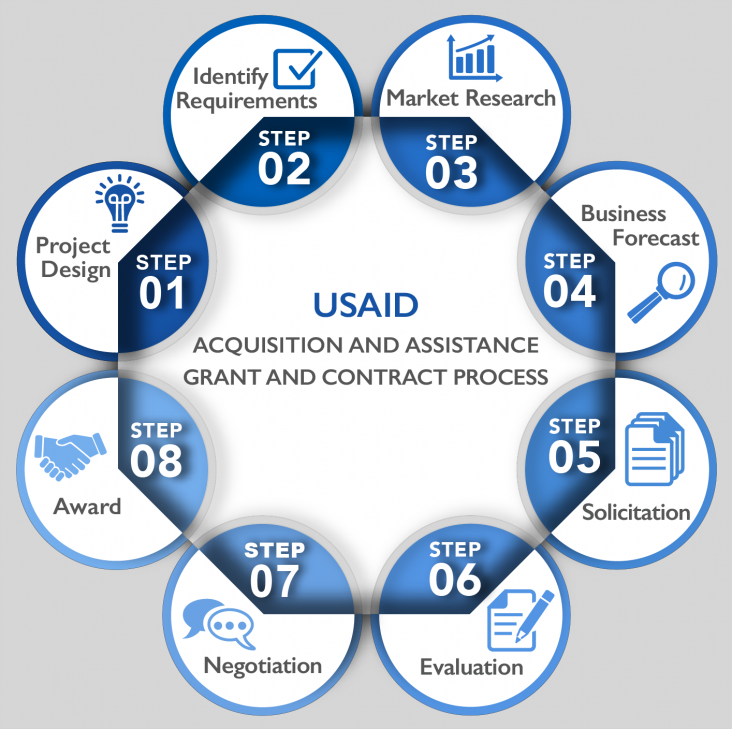Our Process

USAID generally follows the below steps (some steps may overlap):
Step 1. Project Design
USAID Missions develop an overarching Country Development Cooperation Strategy (CDCS) with substantial input from partner governments, industry, civil society, and development partners to understand challenges and resources available. From the CDCS, USAID then designs projects and activities to create an acquisition and assistance (A&A) plan.
Step 2. Identify the Requirement
USAID will work towards defining the results to be accomplished under discrete activities which may be obtained via an assistance or acquisition award.
Acquisition refers to obtaining goods and services, through various types of contracts, for the use or benefit of the Agency. Interested organizations submit a proposal in response to a Request for Proposals (RFP) that states the Agency’s requirements and how USAID will evaluate and select the successful offeror/bidder.
- Contracts - USAID typically exercises a higher level of control over the partner in obtaining results.
Assistance refers to transferring funds (or other valuables) from USAID to another party for the implementation of programs that contribute to the public good and in furtherance of the objectives of the Foreign Assistance Act. Interested organizations submit an application in response to an Annual Program Statement (APS) or Notice of Funding Opportunity (NOFO) which usually provides a program description and how USAID will evaluate and select the successful applicant.
- Grants - USAID does not need substantial involvement with the program implementation.
- Cooperative Agreements - USAID is substantially involved with the recipient inprogram implementation.
Step 3. Market Research
USAID conducts market research to determine how best to implement our development objectives for delivery of foreign assistance. During this step, USAID acquires information on the level of local capacity available and the participation of small business, as well as the feasibility of the requirement. For more information, see ADS 302.
Although not specifically identified as “market research” for assistance, USAID may reach out to potential applicants and use Grants.gov to collect comments and feedback on specific proposed programs.
Step 4. Agency Business Forecast
Once the Agency has decided to pursue an activity, we inform the public through the Agency's Business Forecast. The Forecast provides tentative information about the planned activity.
Step 5. Solicitation
The solicitation (an RFP, NOFO, or APS) provides a description of the requirement or program and how USAID will evaluate the offeror/applicant. USAID uses the following various methods to publish the solicitation:
- Requests for Proposals: FBO.gov is where USAID releases most Agency contract opportunities.
- Notice of Funding Opportunity and Annual Program Statements: Grants.gov is where USAID releases a NOFO or an APS. A NOFO is usually for a specific program (s) and open for a limited time. An APS is normally open for a year and is meant to encourage concept papers on a wider range of programs before a second stage submission of a full application for those concept papers deemed potentially viable.
- Ocean transportation and commodities/goods: Partners in these industries may visit USAID Procurement Announcements for a listing of solicitations.
- Consultant Opportunities: These are available at FBO.gov.
Step 6. Evaluation
As a part of the technical proposal review, typical evaluation criteria include the following:
- Past Performance (does not have to be USAID past performance)
- Technical Approach
- Personnel
- Corporate Capability
- Management Plans
USAID provides the criteria it will use to make an award decision in each solicitation. The solicitation criteria include technical and cost/price factors, and will specify the relative importance of the various factors.
Step 7. Negotiation
Your organization may be contacted by a Contracting or Agreement Officer (CO/AO) if your proposal or application is being considered for an award. Contracting and Agreement Officers will be your organization's key interface for doing business with USAID.
If USAID wants to negotiate with your organization before deciding whether or not to award to you, your organization should learn about our policies that will become a part of the contract or assistance award.
- USAID executes all direct procurement in accordance with ADS 302, the FAR, and USAID’s supplement to the FAR, the USAID Acquisition Regulation or AIDAR.
- USAID executes assistance in accordance with ADS 303 and/or 22 CFR 226.
When it is necessary to implement timely changes prior to a formal amendment of AIDAR, the Procurement/Assistance Executive issues Acquisition & Assistance Policy Directives (AAPDs).
Step 8. Award
Once the above steps are completed, USAID will award to the selected organization. In most cases, the organization will be invited to a post-award conference to discuss implementation and any questions from the organization. Additionally, throughout the implementation period, the organization may contact the Contracting or Agreement Officer’s Representative (COR/AOR) designated in the award for technical guidance. All matters concerning the award must be directed to the Contracting or Agreement Officer.
In the event the organization cannot reach an agreement with the above individual officers, you may contact our Agency Ombudsman.
USAID is dedicated to protecting the integrity of our foreign assistance efforts and the taxpayer funds entrusted through awards. See the Partner Compliance & Oversight website for further information and Red Alert notices.







Comment
Make a general inquiry or suggest an improvement.